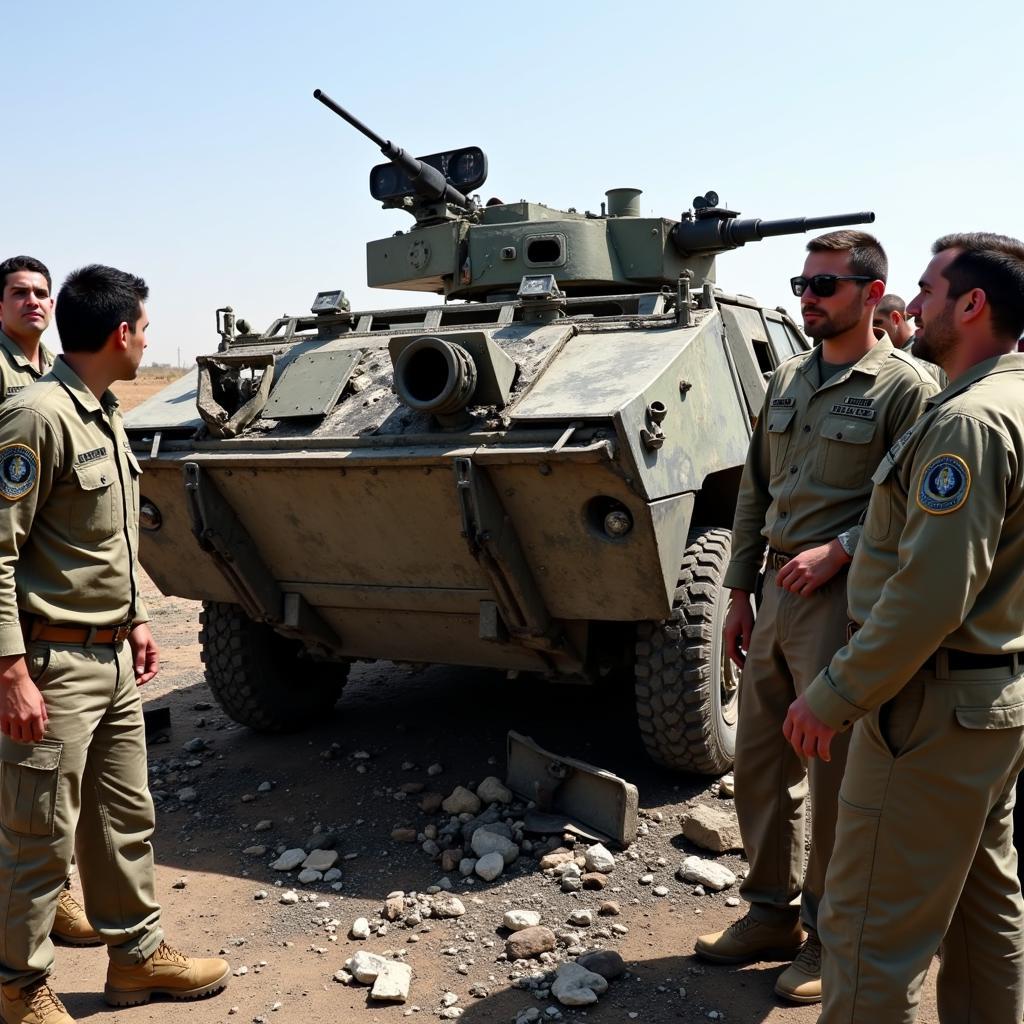Going To Hell In A Damaged Armored Vehicle isn’t a literal descent, but a figurative one – a harrowing experience where survival hangs by a thread. This article explores the challenges, strategies, and psychological impact of operating a compromised armored vehicle in extreme, hostile environments.
When Armor Fails: Navigating the Inferno in a Damaged Vehicle
Operating an armored vehicle provides a sense of security, a mobile fortress against external threats. But what happens when that protection is breached? When your armored vehicle is damaged, the environment shifts from a position of relative safety to one of intense vulnerability. Every crack, every malfunction, amplifies the danger, turning the once-secure vehicle into a potential death trap. This is the reality of “going to hell in a damaged armored vehicle” – facing a cascade of challenges that demand quick thinking, resilience, and a deep understanding of both the vehicle and the surrounding threats.
The Challenges of a Compromised Armored Vehicle
A damaged armored vehicle presents a multitude of challenges:
- Reduced Mobility: Damage to the tracks, wheels, or engine can severely hamper movement, making the vehicle a sitting duck.
- Weakened Protection: Breaches in the armor expose the crew to enemy fire and explosions.
- Malfunctioning Systems: Damaged electrical systems, communication equipment, or weapon systems cripple the vehicle’s offensive and defensive capabilities.
- Psychological Impact: The loss of the perceived invincibility of the armor can severely impact the crew’s morale and combat effectiveness.
Maintaining composure and focusing on immediate actions are crucial for survival. Rapid assessment of the damage, prioritizing repairs, and adapting tactics to the new reality are essential.
Strategies for Survival in a Crippled Metal Beast
Survival in a damaged armored vehicle relies on a combination of preemptive measures and reactive strategies.
-
Preemptive Measures:
- Thorough Vehicle Maintenance: Regular checks and meticulous upkeep can prevent malfunctions and mitigate the impact of damage.
- Crew Training: Extensive training in damage control, emergency repairs, and combat operations under pressure is essential.
- Redundancy in Systems: Backup systems for critical functions like communication and mobility can be lifesavers.
-
Reactive Strategies:
- Rapid Damage Assessment: Quickly identify the extent and nature of the damage.
- Prioritized Repairs: Focus on restoring critical systems like mobility and communication first.
- Tactical Retreat or Repositioning: If the damage is too severe, a strategic retreat or repositioning to a more defensible location is paramount.
- Communication and Coordination: Maintaining clear communication with other units or command is crucial for coordinating support and extraction.
“The ability to adapt and improvise is key,” says former armored vehicle commander, Colonel John Smith, “When your armor is compromised, your standard operating procedures may no longer apply. You need to think on your feet and make quick decisions based on the evolving situation.”
The Psychological Toll of Vulnerability
The psychological impact of operating a damaged armored vehicle should not be underestimated. The perceived safety of the armor is shattered, and the crew is confronted with the stark reality of their vulnerability.
- Fear and Anxiety: The constant threat of enemy fire and the potential for further damage can induce fear and anxiety.
- Claustrophobia: Being confined within a damaged and potentially immobile vehicle can exacerbate feelings of claustrophobia.
- Loss of Confidence: The loss of the protective shield can erode confidence and morale, impacting combat effectiveness.
Addressing the psychological needs of the crew is as important as addressing the physical damage to the vehicle. Open communication, mutual support, and strong leadership are crucial for maintaining cohesion and resilience.
 Soldiers Assessing Damage to Armored Vehicle
Soldiers Assessing Damage to Armored Vehicle
“It’s not just about fixing the metal,” says Dr. Emily Carter, a military psychologist, “It’s about supporting the individuals inside. Their mental resilience is as crucial as the armor itself.”
Conclusion
Going to hell in a damaged armored vehicle is a harrowing experience that tests the limits of human endurance and ingenuity. While advanced technology and robust armor provide a degree of protection, it’s the human element – the training, the teamwork, the resilience – that ultimately determines survival. By understanding the challenges, adopting effective strategies, and addressing the psychological impact, crews can navigate the inferno and emerge from the experience stronger and more prepared.
FAQ
- What are the most common types of damage to armored vehicles?
- How can crews prepare for operating in a damaged vehicle?
- What are the key factors that contribute to survival in a damaged vehicle?
- What are the long-term psychological effects of operating a damaged vehicle?
- How can military organizations better support the mental health of their armored vehicle crews?
- What are some advancements in armored vehicle technology that aim to mitigate the impact of damage?
- How does the terrain and environment influence the challenges of operating a damaged vehicle?
Need further assistance? Contact us at Phone Number: 0902476650, Email: [email protected] Or visit us at 139 Đ. Võ Văn Kiệt, Hoà Long, Bà Rịa, Bà Rịa – Vũng Tàu, Việt Nam. We have a 24/7 customer support team.





